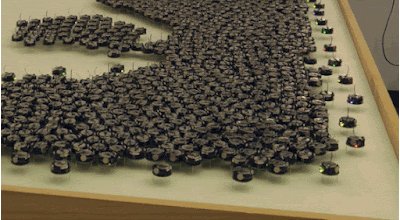Could robotics enable a complete or near complete takeover with minimal response ?
by noreply@blogger.com (brian wang) from NextBigFuture.com on (#2E9T1)
In World War 2, French armored doctrine used tanks to support slow moving infantry armies. While generally armed with heavier guns and having thicker armor than most German tanks, they were also slower, rarely had radios to enable them to fight effectively in groups or to exploit rapidly changing battlefield conditions, and often had ineffectual one man turrets. In contrast, the Germans viewed their tanks as primary fighting vehicles that would spearhead deep attacks into the enemy's rear as part of a combined arms team. The Germans consequently put a premium on balancing armor, firepower, maneuverability, and reliability. They also equipped most combat vehicles with radios to facilitate both effective maneuvering of large formations and rapid coordination with air assets

Most militaries continue to look at warbots as support weapons that can conduct reconnaissance, selective strike, and logistical or other supporting tasks.
However, robots can be faster and cheaper than humans. Robots could enable entirely new attack and defense capabilities by fully utilizing robotic, sensors, AI and other capabilities.

There is a discussion of Blitzkrieg, Soviet Deep Battle and NATO Air land battle.
* use massively superior mobility and heavily concentrated forces to breakthrough the line of battle and collapsing their front into several pockets of resistances.
* envelop larger, less mobile infantry forces and isolate them from each other
* The concept of bypassing enemy strong point to attack the weaker spot and left the those strong point enveloped was used perhaps for as early as the Mongol Invasion of Europe
Stealth Robotic Deep Strike
The Mongols were the earliest user of Blitzkrieg as a concept. The art of war is always about how to defeat the enemy without actually having them fight back.
Currently the concepts are to use robots for surveillance or as extra weapons for planes and soldiers.
A revolution would be where robotics were able to perform superior infiltration and sabotage or misdirection. This would not just be in the small scale but enabling a complete takeover without a response from the opponent.

Read more











Most militaries continue to look at warbots as support weapons that can conduct reconnaissance, selective strike, and logistical or other supporting tasks.
However, robots can be faster and cheaper than humans. Robots could enable entirely new attack and defense capabilities by fully utilizing robotic, sensors, AI and other capabilities.

There is a discussion of Blitzkrieg, Soviet Deep Battle and NATO Air land battle.
* use massively superior mobility and heavily concentrated forces to breakthrough the line of battle and collapsing their front into several pockets of resistances.
* envelop larger, less mobile infantry forces and isolate them from each other
* The concept of bypassing enemy strong point to attack the weaker spot and left the those strong point enveloped was used perhaps for as early as the Mongol Invasion of Europe
Stealth Robotic Deep Strike
The Mongols were the earliest user of Blitzkrieg as a concept. The art of war is always about how to defeat the enemy without actually having them fight back.
Currently the concepts are to use robots for surveillance or as extra weapons for planes and soldiers.
A revolution would be where robotics were able to perform superior infiltration and sabotage or misdirection. This would not just be in the small scale but enabling a complete takeover without a response from the opponent.

Read more